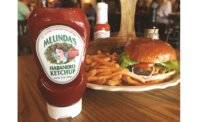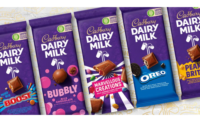Machinery
German Chocolate Factory Gets Turned Upside Down
A TLM system from Schubert saves Ritter Sport storage space and cardboard packaging.

Colorful variety is what the most famous chocolate bar in the 100g format from Ritter Sport stands for. Its dimensions are just as varied as the many different types of chocolate offered. Even a difference of three millimetres in thickness between products represents a challenge when it comes to shelf-ready packaging, a process that has so far only been solved by hand in a time-consuming and costly manner. Ritter Sport was therefore looking for a system that would pack the 100g bars in the correct formation and reliably recognize how many bars had to be sorted into the carton, depending on the thickness of the variety. The new compact TLM case packer now handles this process fully automatically and directly on-site within the production chain. Thanks to a specially developed single-piece carton, Ritter is able to save an additional 30% of storage space.
The first AlRiKa Krem-Schokolade chocolate brand from the chocolate and confectionery factory founded by Clara and Alfred E. Ritter in Cannstatt, Stuttgart, Germany launched as early as 1912. Yet the worldwide breakthrough came 20 years later with the Ritter’s Sport Schokolade brand (today, Ritter Sport Schokolade), which was introduced in 1932. With the slogan “Square. Practical. Good.” the square chocolate bar from Germany has secured a place in the best-selling list of popular brands and enjoys international popularity today.
One reason for the company’s ongoing success story is that sustainability has always been a top priority at Ritter Sport. Ritter Sport is extensively testing a new type of special paper packaging and checking its suitability for everyday use as part of a major campaign with 500 loyal chocolate fans.
A 3-Millimeter Challenge
The packaging process for the 100g bars was recently put to the test from a sustainability perspective. Due to the different dimensions of the individual varieties, sorting and shelf-ready packaging previously had to be done manually in an outsourced logistics process. The existing system could not automatically cope with differences of up to three millimeters in thickness for product types such as nougat and whole nuts.
“We wanted to optimize this complex process in a cost-efficient and sustainable manner. That’s why we were looking for a system as an in-house solution that would pack our 100g bars directly in the right formation and reliably detect whether 10, 11, 12 or 13 bars, depending on the thickness of the variety, needed to be sorted into the carton,” explains Ivo Bǔncǔga, head of technology at Ritter Sport. This was the question with which he approached packaging machine manufacturer, Schubert. Ritter Sport and Schubert have enjoyed a long-standing partnership — with seven TLM system. Jonas Müller, project manager at Schubert, developed a compact, flexible and cost effective machine solution for the company within a very short time.
Intelligent technology for individual packaging sizes
The new machine combines a collating device, three F2 robots to erect, fill and close the cartons, and a downstream turning unit in a single frame. It is also flexibly designed enough to allow the option, depending on the production order, to connect it to the existing packaging machine for packaging in alternative cartons via an additional height-adjustable pivoting conveyor. As a rule, the 100g bars are fed directly from a flow-wrapping machine to the Schubert system on a single track at a speed of 400 bars per minute. The bars are sorted by thickness via a grouping chain into the right numbers to fit inside the carton.
Turning Things Upside Down
Before the cartons are filled with chocolate bars, they must be erected from one-piece blanks stored flat in a magazine. “The fact that the cartons no longer consist of two parts — the bottom and the lid — means we can simplify and speed up the packaging process many times over,” says Müller. The flat blanks are taken from the magazine, and then glued and pressed through a folding frame by an F2 robot. The erected carton is then placed onto a vacuum conveyor upside down. This transports the boxes through the system to the grouping table. There, an F2 loading robot takes the products and inserts them upside down into the carton lid. Another F2 robot closes the attached base part and places the carton in the turning unit, which turns the cartons 180 degrees and places them on the discharge belt.
Sustainability Standards
Thanks to the new system, no time-consuming format changes are required during operation; only the grouping tables vary due to the different thicknesses of the bars and they can be changed quickly and easily using just one tool.
“This really is a fantastic ‘toy’ that Mr. Müller and his team built for us, and it meets our precise requirements as an innovative and sustainable company that sets new standards,” says Asmus Wolff, managing director and supply chain manager at Ritter Sport. With the new system, Ritter Sport is saving 30% on storage space and carton packaging. This can now be used to implement even more demanding sustainability standards. The family business has already received several awards for its extraordinary commitment in this area.
For the Love of Sports
The chocolate, which has been popular among chocolate lovers for more than 100 years, was not originally square and, in fact, wasn’t called Ritter Sport. First sold in 1912, the branding came down to a ground-breaking idea by Clara Ritter in the 1930s. She developed a chocolate square with the same weight as a long chocolate bar, but it could fit perfectly inside the pockets of football fans’ sports jackets without breaking. This marked the birth of the Ritter Sport brand, which has more than 22 delicious varieties.
Looking for a reprint of this article?
From high-res PDFs to custom plaques, order your copy today!






